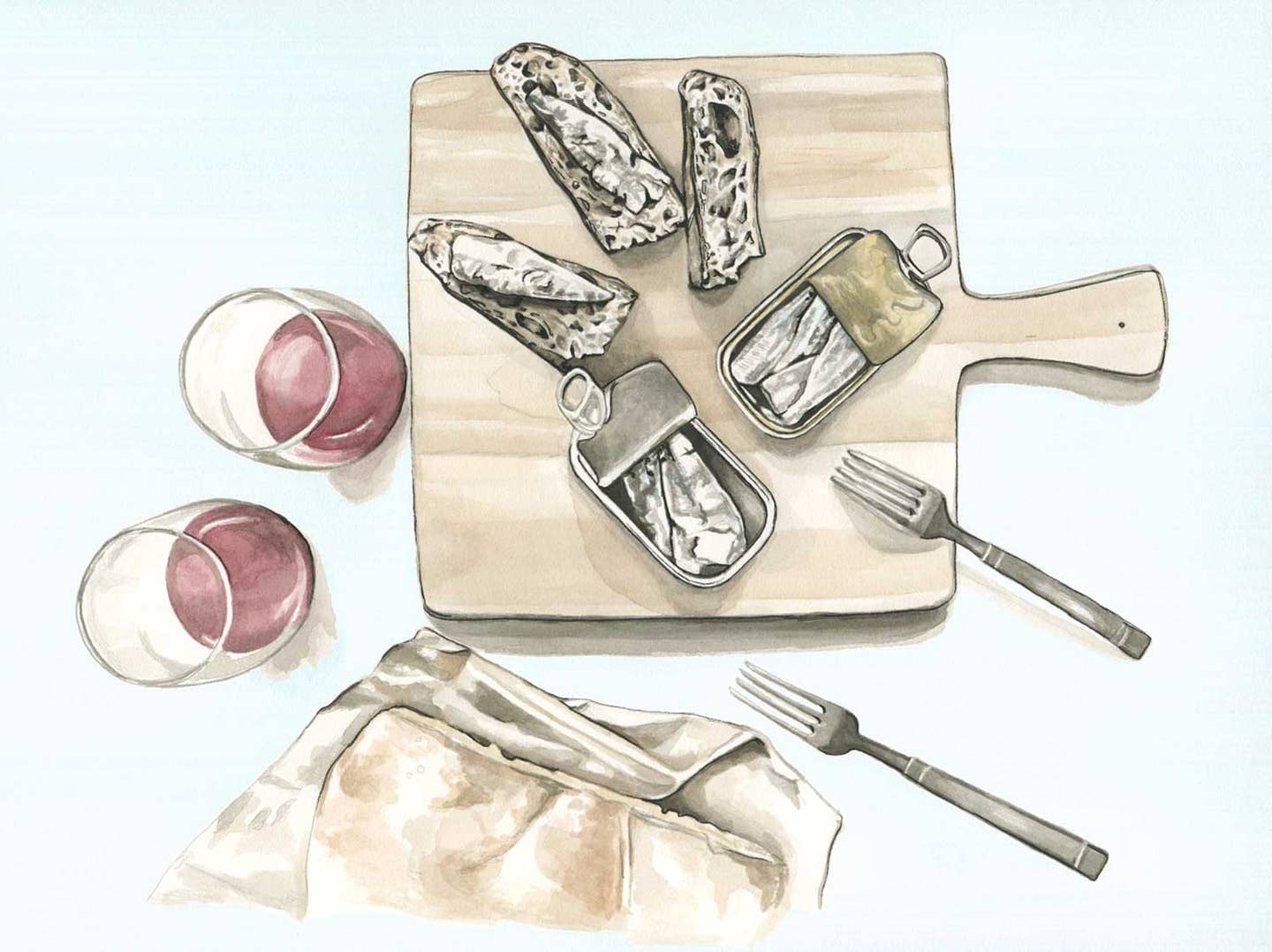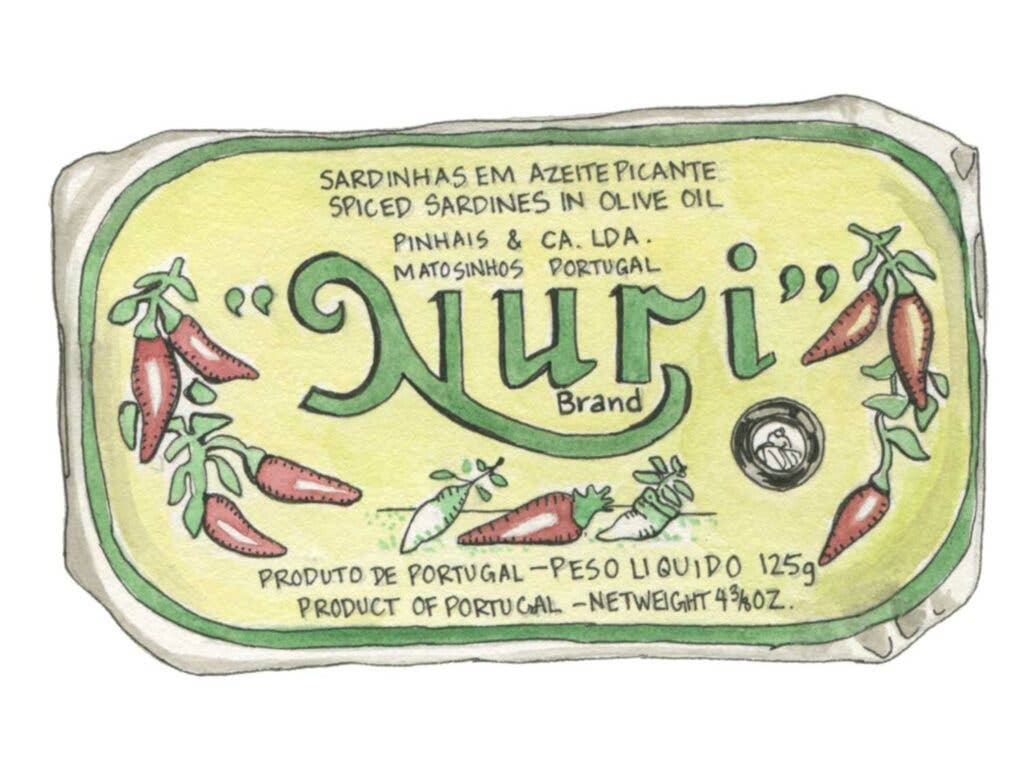
How The Sardine Became a Portuguese National Icon
This humble tinned fish has made a big splash in Portugal and beyond
The Portuguese are head-over-heels for a certain sleek and shimmering figure. No, it’s not soccer star Cristiano Ronaldo—it’s the tiny, humble sardine.
The oily fish has been a staple of the area's trade and diet ever since the Romans discovered it in abundance off the coast. Widely available, a healthy source of protein and minerals and delicious to boot, perhaps it's no surprise that the sardine became, as Nuno Rocha, sales director of the cannery Pinhais, jokingly puts it, "the third marvel of the country, after soccer and sunlight."
Yet, if you travel to Portugal, you'll quickly find that the sardinha most celebrated these days is not the one blistered and hot off the grill, but the one preserved in a tin. Even more so than bacalhau (salt cod) or cavalinha (a type of mackerel), the sardine is stitched into the cultural and economic fabric of the country, and lies at the heart of the Portugal's preserved seafood tradition, or conservas. An industry that "has survived almost two centuries, through wars and revolutions," remarks Vincent Vicente, industry researcher at Lisbon restaurant Can the Can. "It's the oldest and dearest…of our land."
Although the practice of canning fish officially began in 1824 in Nantes, France, it was in the 1850s that it really took off in Portugal. Sardines were the fish du jour of that time, and their abundance and impeccable quality—coupled with the country's extensive coastline and ancient fishing traditions—sparked the industry's genesis.
Over the next few decades, French entrepreneurs, whose own factories were taking a hit from sardine shortages at home, further aided development by directing their attention and capital to Portugal. Constant yields and foreign investment turned the burgeoning field into a full-fledged industry. By 1912, Portugal was the top worldwide exporter of canned fish—with sardines comprising the bulk of exports, followed by tuna. In 1925, with World War I escalating the need for pre-packaged and shippable foods, some 400 canneries were in operation.
After the end of World War II, however, with no far-flung troops to feed, many of these factories shuttered. In the following few decades, overfishing, conflict abroad, and the 1974 revolution further took a toll on the sector. The industry eventually recovered slightly in the ‘80s, but at that point, tinned sardines had taken the back shelf in the minds of the Portuguese. According to Vicente, 90% of the country’s production then was for export.
For those that did stay in Portugal, the tins were simply another pantry item—something to take along on a trip to the beach or camping. It was especially popular among students and the working class, who turned to them for their convenience and low cost. Today, however, the tinned sardine has evolved into a highly sought-after product: “Portugal has elevated the sardine to the pinnacle of its culinary culture.” observes Vicente.

Each June, all 10.3 million of Portugal’s residents seem to step outside in celebration of the annual Popular Saints’ Festivals. During the month-long cookout, the streets of major cities are filled with laughter, dance, and the scent of sardines as they’re licked by the flames of the grill. Served atop a hunk of bread to soak up the oil, the beloved fish is one of the defining features of the festivities.
For Nuno Rocha, the attention began to shift to conservas as chefs, nutritionists, and consumers realized that they were more than an accessible and affordable source of seafood; they were also delicious in their own right, made with high-quality fish, and many packed in tins by hand. As the sardine’s fishing season was regulated and shortened to address the diminishing stock, they became a more exclusive treat. Nowadays, the tinned sardine is championed by food industry leaders and spotlighted thousands of ways by the new crop of locavore restaurants and cafés.
For instance, at Porto's Tábua Rasa, diners can order 15 types of tinned seafood to build elaborate and curated "boards"—and one-third of them are sardines. At Vicente's Can the Can, which opened in 2012, the sardines are incorporated into sophisticated, inventive dishes and sold by the tin at their "old shop" retail counter.
Another obvious, if not stronger, driving factor for the sardine’s step into the limelight has been the boom in tourism. “The industry is driven by tourists looking for something traditionally Portuguese,” Rocha observes. Proud of their food legacy, it’s only natural that the Portuguese respond by offering up the one fish they’re most skilled in preserving.

As a result, tins of sardines, along with other conservas, have become highly-coveted souvenirs. Tourists can stock up at the grocery store, at restaurants like Can the Can, and at conserveiras, entire establishments devoted to the craft. The largely family-owned Conserveira de Lisboa has been serving customers since 1930—and its interior remains much the same as it did back then. The nationally-sponsored Loja das Conservas represents and sells over 300 varieties from canneries all over Portugal. Their best seller? Well, the sardine of course.
Yet, Rocha warns that not all of them are worth their price tag. Many companies tout their can as “gourmet” but don’t adhere to the highest standards—compromising in quality, sourcing, and processing as they mechanize production to become more efficient. Today, Pinhais is one of a few canneries that still maintains the artisanal process of canning by hand—with sardines accounting for 95% of output.
The sardines are making a splash abroad as well. "I truly love to see the shift that occurs when we introduce [sardines]—gently—as the go-to novice choice," says Kathy Sidell, founder of Boston's Saltie Girl. "I think people are knocked out by how good they are. They keep coming back." Saltie Girl boasts one of the largest collections of tinned seafood in New England (22 of the 65 are sardines), and joins the ranks of restaurants that are slowly exposing the American public to the artisan world of sardines and other European preserved seafood.

Bryan Jarr, of Seattle's JarrBar, was surprised how quickly, once he began to offer them, the Portuguese sardines became a bestseller. But then again, he says, "they're versatile, inexpensive, and when done right, taste incredible. If you try and love these, you'll fall for all the other [tinned varieties] too."
And truly, what’s not to love? They tap into a rich culture and way of life, provide a gateway to new flavors and foods otherwise missed, and are a sustainable alternative to overfished tuna and salmon. It’s a direct challenge to our notion that the best foods are only the most fresh, but the tides are in favor for the little, yet mighty fish.
“The quality and variety of [Portuguese] sardines is a game changer, dispelling the way Americans used to think of this somewhat common fish,” remarks Sidell. “It’s time to give Bumble Bee a run for its money.”
Keep Reading
Continue to Next Story










